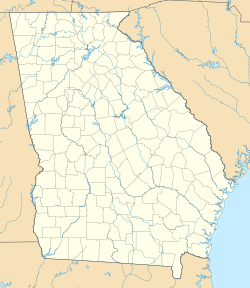Sixtoe Mound facts for kids
| Location | Murray County, Georgia, |
|---|---|
| Region | Murray County, Georgia |
| Coordinates | 34°36′44.53″N 84°40′29.78″W / 34.6123694°N 84.6749389°W |
| History | |
| Cultures | South Appalachian Mississippian culture |
| Site notes | |
| Excavation dates | 1962-1965 |
| Archaeologists | Arthur Randolph Kelly |
| Architecture | |
| Architectural styles | platform mound |
The Sixtoe Mound (also known as 9MU100) is an ancient place in Murray County, Georgia. From 1962 to 1965, archaeologists led by Arthur Randolph Kelly dug up this site. They were working on a project for the National Park Service near the Carters Dam. The site included a low, flat-topped hill called a platform mound and a nearby village. Most of the mound was explored, but only a small part of the village was dug up.
Contents
Exploring Sixtoe Field
Digging at Sixtoe Field started in 1962. Archaeologists explored about 25 acres (10 hectares) of land. They found a workshop area where ancient people made tools. They discovered over a ton of stone pieces in different stages of being shaped. Some stones had been heated or burned.
Most of the stone was quartz, with a small amount of slate, limestone, and flint. Very few finished tools were found. This suggests that the main activity here was making tools during the Late Archaic period. The quartz did not come from this exact spot. Instead, it was brought from the nearby Coosawattee River streambed.
Ancient Homes and Food
Archaeologists also found a village site. They used a special probe to find "hardpan," which is a tough layer of soil. This layer often shows where a house floor used to be. They focused on digging up two house structures.
Structure #1 was likely a house about 20 feet (6 meters) by 20 feet (6 meters) with rounded corners. It had an entrance on the south side and a fireplace in the middle. The walls were probably made from young trees bent and tied together. Mats made of cane might have covered the walls. Structure #2 was similar but had slightly different patterns of post holes.
Both structures had similar amounts of artifacts and trash on their floors. Most of the broken pottery pieces found in these houses were of a type called Dallas Plain.
The "trash pits" in the village showed what these ancient people ate. They found many animal bones, especially deer bones. Bones from small mammals, fish, and turtle shells were also common. Besides animal remains, they found many charred acorns and hickory nuts. This shows that these people ate a very traditional diet. Interestingly, there were almost no charred corn pieces, which are often found at other sites from this time.
The Sixtoe Mound Structure
Most of the archaeological work happened at the Sixtoe Mound itself. The Sixtoe Mound was a low, wide platform mound made of solid clay. It was probably about 7 feet (2 meters) higher than the land around it. This was important because when the Coosawattee River flooded, the mound would become like an island.
The Sixtoe Mound was built in several layers:
- Zone A: This was the original ground layer under the mound. It was dark clay with a lot of silt.
- Zone B: This was the first layer of dirt added to build the mound. It was dark, almost black clay with organic material, charcoal, and some scattered trash. This layer was about 20 to 30 inches (50 to 76 centimeters) thick and formed the main part of the mound.
- Zone C: A thin layer of yellow-brown sand, about 2 to 6 inches (5 to 15 centimeters) thick, was found here. It looked like it was laid down by water.
- Zone D: This layer was made of clay carried in baskets.
- Zone E: This was the top surface of the Sixtoe Mound.
Mound Features and Purpose
One interesting feature of the mound was the stone boulders found along its eastern side. These boulders weighed from 2 to 75 pounds (1 to 34 kilograms). They formed a continuous wall, about 12 to 14 inches (30 to 36 centimeters) wide. This stone wall likely helped stop the mound from eroding.
The Sixtoe Mound was located over 1,200 feet (366 meters) away from the village. This suggests it was a special place, perhaps a ceremonial center. Large, dormitory-like buildings were found on top of the mound. Two of these were very big, about 40 feet (12 meters) by 70 feet (21 meters). These buildings were not burned down. Instead, when one building wore out, a new one was built right on top of its remains.
Unlike the village, there was very little trash found inside these mound structures. Trash was probably thrown into pits created when the mound was built. These pits contained few animal bones, ash, or charcoal, which was different from the village trash pits.
Archaeologists also found broken pieces of pottery. About three-quarters of this pottery was plain or had complicated stamped designs. It was made with limestone temper, which is a material added to clay. This was unusual because other sites in the area had pottery with shell or sand temper. Other artifacts found included shell hoes, bone tools called awls, a rough stone spade, arrowheads, flint knives, and stone "napkin ring" ear spools.


